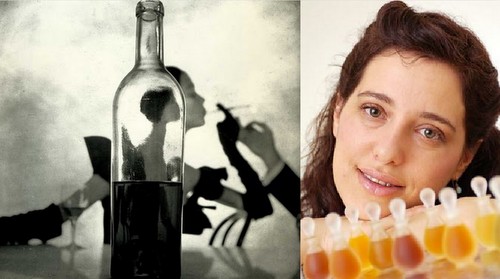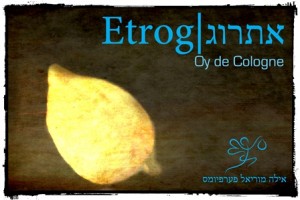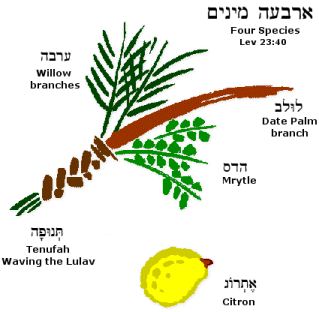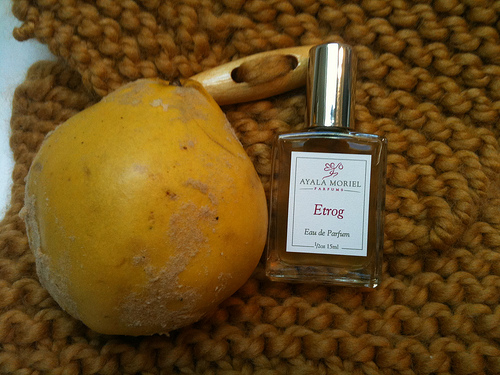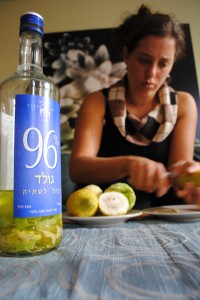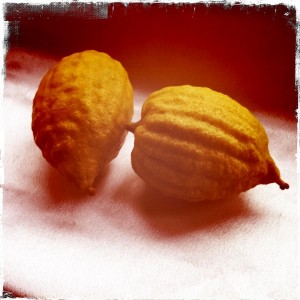Some fragrances have a rich back story, which are almost as intriguing as the scent itself. Natural Perfumer Ayala Sender of Ayala Moriel Parfums newest fragrance, Etrog Oy de Cologne is fascinating on many levels; it has taken years to create and the key ingredient is a fruit that is approximately 2000 years old with many historic, mystical, cultural and religious meanings.It is also rarely used in perfumery.
Ayala, why did you name your newest fragrance Etrog Oy de Cologne?
AM: Etrog means citron (Citrus medica) in Hebrew. It is an unusual citrus fruit with pineapple and flower aromas that is one of the four botanical symbols in the holiday of Sukkot. Because the word – and the fruit – is unfamiliar and exotic to most people, so the Jewish sigh "Oy" makes is extra clear of its Jewish heritage, even if they might not have ever heard of Etrog before. And most importantly – I wanted to put a smile on people's face. This is exactly what I get every time I hand out one of my Etrog postcards!
What is Sukkot?
AM: Sukkot is the Jewish autumn harvest holiday in the month of Tishrei. It's a week long holiday at the beginning of the rainy season in Israel, where Jews are forced out of their comfort zone and live in a 3-walled hut called "Sukkah" in memory of their ancestors in the desert. An important virtue of the holiday is hospitality: each day there is an ancestor spirit that visits the Sukkah (i.e.: Abraham, Issac, Jacob, Joseph…) and having guests over every day to break bread together is encouraged.
Please explain the "four species" that represent the holiday and were they all used in Etrog de Cologne
AM: During the holiday, there 4 significant botanical symbols that are blessed upon – each with its own unique qualities, and representing a different type of person or body part:
Arava (willow branches), which posseses neither aroma nor flavour, and is likened to a simple, unaccomplished person who has no knowledge and doesn't do any good deeds either. Willow's long leaves represent the lips.
Lulav (young palm leaf), possess no scent, but has a good taste (sweet dates, anyone?). It is likened to a person who is very studious, but being so absorbed in his/her studies, spares not time to do good deeds. The palm's long leaves represent the spine.
Hadass (myrtle), which possess a fine aroma, but has no good taste (it's very bitter!), like a person who is dedicated to doing good deeds, but has no inclination for studying. Myrtle leaves represent the eyes.
Etrog (citron fruit), which is said to be the most superior to all, as it posses both good taste and scent, and is therefore likened to an accomplished person, who is both well-learned and does good deeds. Ctiron is shaped like the heart, and therefore is the most guarded of all 4 species. It is usually kept in a beautifully designed box, cushioned with cotton balls or silk, and throughout the holiday one must be careful to keep its perfection, and especially not harm or damage it's "Pitam" (the "nipple" which you can also find on lemon fruit).
Citron and Myrtle are used in the composition.
What are the unique fragrant properties of the citron fruit and its significance in Jewish folklore?
AM: Etrog has a unique citrusy aroma – reminiscent more of pineapple, quince, pomelo and flowers than any other citrus fruit – although it can be a little lemony with some specimens. Etrog was said to be the mythical "Manna" – the food from the sky that nourished the Israelites in the Sinai desert, where they wandered for 40 years before entering the country. In this midrash, it is said that it brought from Calabria (in Italy) on the wings of Angels (most likely it was introduced in Roman Italy by Jews celebrating Sukkkot in the second century); which is why some Hassidic Jews only buy Etrogim from Calabria (which are fine indeed!) Etrog is one of those intriguing themes in Jewish folklore and tales. Like perfume, it walks both paths of being holy and with medicinal properties; yet with irresistible seduction powers.
One story I remembered vividly reading as a young girl was that of a child in Europe who is bascially seduced by the fruit, and is compelled to bite the Etrog's "nipple". After much internal struggle (which was very powerfully described), he does that indeed and of course – regrets it the moment he does it, trying to reverse what he has done.
(Editor's Note: Seduction seems to be a consistent theme in the mysterious legends surrounding the Citron. There are many myths attached to the Etrog, which is also called the Persian Apple from the Persian word torang. Scholars since the times of the Ancient Greek's believe it to be the Forbidden Fruit in the Garden of Eden. I also remember being urged to bite the titum (nipple) during my first marriage because a superstitious relative said I would get pregnant within a year…I did not bite.-MC)
Ayala preparing her tincture of organic Etrog (citron)
Etrog was over four years in the making. What were the unique challenges in creating this scent?
AM: Etrog is only grown commercially in two places- Calabria and Israel, where it is used exclusively for supplying the world wide Jewish population with the sacred fruit for the holiday. It is impossible to find it any other time of the year but around Sukkot, and even than it goes for $40 a piece. The year that I met Rabbi Binyomin Bitton, the Rabbi of the Chabad Downtown in Vancouver was actually a "Shmita" year – one when you are not allowed to use or enjoy the food grown on trees in Israel. He tried to find me Etrogim from Calabria that year, but to no avail. I had to wait till the next year, and since then, every year, he promptly donates his Etrogim for me to experiment with. I'm lucky that he has two sons, so every year, he has at least 3 of them! I am very thankful for him, and also to neighbors in my village and to my mother, who diligently tinctured the zest of Yemenite citron fruit that they grow, and sent it to me to include in the Etrog Oy de Cologne.
After three years of collecting Etrogim and tincturing them, it was a matter of composition. I tried to use as many of the species as possible in this perfume. There is no scent to willows, but myrtle essential oil is wonderful. So I've used green myrtle, and also lemon myrtle which my oldest brother found in one of his trips to Australia. I used Etrog tinctures from several years, and also eventually found some essential oil (although it wasn't nearly as good as the tinctures!), and more of Petitgrain Cedrat (which is essential oil from the leaves and twigs of Etrog), which I wasn't able to find for years, but that Mandy Aftel has gifted me with when I first met her in her Berkeley studio last July. For the palm, I used Balsam Poplar Buds absolute, whose scent reminds me of fresh date fruits, and also other fruit. It fills the air each spring in Vancouver: a sweet, resinous, honeyed aroma redolent of dates and apricots, pomelo & citron pith, and with a fluffy texture of fresh cotton balls. It was challenging to find the right heart notes – and the balsam poplar buds truly were the missing element that put the perfume together, so to speak.
Why is Etrog Oy de Cologne is being introduced for Father's Day?
AM: Last year I launched Orcas for Father's Day and it was so well-received by gentlemen who are seeking all-natural and cutting edge fragrance – that I wanted to bring out another scent that will be suitable for men at the beginning of summer. Also, with Etrog being a modern Eau de Cologne formulation (although, I must say, it is an Eau de Parfum concentration!), it's very suitable for summer, and I'm sure that just like Orcas – ladies are going to enjoy it just as much. Last but not least, launching it now will allow enough time for discerning Jews to sample it and stock up for the fall when Sukkot comes around on October 1, 2012! (Editor's Note: the Etrog is called the father of all lemons, so it is indeed great timing).
– Michelyn Camen, Editor In Chief
To celebrate Father's Day (and Ayala's eleven years in Natural Perfumery) Ayala Moriel is offering 15ml of Etrog Oy de Cologne ($120.00 value) as a draw to one CaFleureBon reader. To be eligible please leave a comment on what you learned about the Etrog or Ayala's creative process as well as other notes in the composition. Draw ends Sunday (Father's Day) June 17, 2012
We announce the winners only on site and on our Facebook page, so Like Cafleurebon and use our RSS option…or your dream prize will be just spilled perfume.

